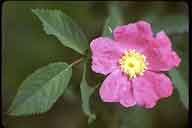Native California Roses
copyright Barbara
Ertter, 2001

ertter@uclink4.berkeley.edu
This website is an on-line monograph of native Rosa in California, prepared by the author of Rosa for
The Jepson Manual: Higher Plants of California. It will be updated as necessary to reflect significant new information and any resultant changed taxonomy. Intended for use by a broad audience, the site includes:
- A Key to Species of native and naturalized roses in California
- Original descriptions from which treatments in The Jepson Manual
were prepared
- Photographs for each species, emphasizing diagnostic characters
- Distribution maps based on documented localities
- Discussions of taxonomic problems, horticultural potential, and other comments of general interest (as presented in various talks, including "Out of the Wild and Into the Garden," a
symposium held March 1999 at Rancho Santa Ana Botanic Garden, Claremont, California)
- Links to selected websites with additional information
top of page
The nine species of native roses currently recognized as occurring in California are arranged in the following three groups:
- A. Thicket-Forming Roses: (Subg. Rosa, Sect. Cinnamomeae)
The native thicket-forming roses of California, which are those most frequently encountered, tend to form large shrubs or dense thickets. The 2--3 pairs of leaflets are most often single-toothed (i.e., the evenly sized teeth form a single series)
and lack marginal glands. All generally grow best in full sun, with root access to a plentiful supply of ground water.
The four species recognized are distinguished by the characters in the Comparative Table. A primary distinction between the four species involves the prickles (technically not thorns, which are anatomically different structures). This character is best observed
at middle parts of the stem; prickles at the base of the plant are often significantly denser, straighter, thicker, and/or otherwise morphologically dissimilar to those on middle and upper parts of the plant. This dimorphism is also sometimes expressed in heavily damaged plants, perhaps as a damage-triggered defense against further predation.
IMPORTANT NOTE: the distinctions between rose species are best understood as broad generalizations, with
ample room for overlap, intergradation, and exceptions. They furthermore completely break down in north-central California, where representatives of the thicket-forming complex stubbornly resist efforts to shoe-horn them into neat and tidy pigeonholes. This apparent intergradation exists in spite of different ploidy levels, with existing chromosome counts indicating that R. pisocarpa and R. woodsii are diploids (n=7), R. californica is tetraploid (n=14), and R. nutkana is hexaploid
(n=21).
top of page
- B. Wood and Ground Roses: (Subg. Rosa, Sect. Gymnocarpae)
The most significant changes between the treatment presented here (and in The Jepson Manual; see Historical Background)
and previous treatments involve the ground roses. This term refers to the three short-growing, openly rhizomatous species R. bridgesii, R. spithamea, and R. pinetorum (the last only tentatively placed in this group), which occur only in California and southern Oregon. They are probably related to the wood rose, R. gymnocarpa, though this is only a tentative conclusion based on limited morphological and biogeographic evidence. In addition to habit, the four species tend to differ from the thicket-forming roses in the generally double-toothed leaflets, with the teeth often gland-tipped; the less well-developed sepal tips; and greater shade tolerance.
- C. Subg. Hesperhodos
top of page
Additional topics, lists, and tables:
Acknowledgements:
Funding for field work, photographs, and digitization provided by the Lawrence R. Heckard Endowment Fund. The efforts of the curatorial staff at CAS/DS, HSC, NDG, NY, RSA, SD, and US are gratefully acknowledged, as are those of the University of California Botanical Garden, who have provided propagation facilities and tender loving care to my prickly charges. Special thanks go to Vern Yadon and Corky Matthews for field assistance in northern Monterey County; to David Chipping and David Keil in San Luis Obispo County; and to Cindy Burrascana with Rosa minutifolia. I am indebted to Christopher Baysdorfer and his students for undertaking preliminary macromolecular analysis of R. gymnocarpa.
top of page
